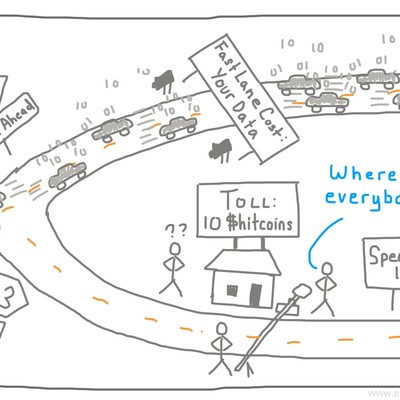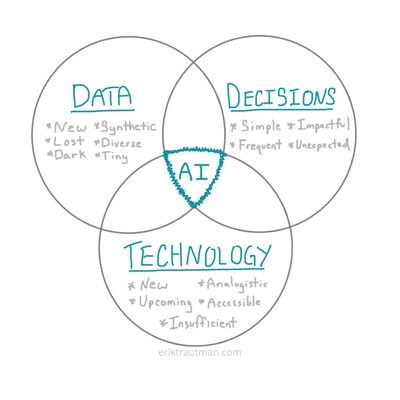What it Means to be AI-Driven

The conversation about Artificial Intelligence has become so muddy lately that it is important to be very clear about what we mean when we say an organization is "using AI" or is "AI driven". This post will clear up those definitions and some of the implications of each classification.
There are three levels at which an organization can adopt artificial intelligence:
- AI-Assisted: AI is a technical bolt-on to existing processes, usually through the use of AI-created tools, for example AI assisted sales or team management tools.
- AI-Enabled / AI-Augmented: AI is applied to existing processes or product data to make the product or service better or more useful, for example the recommendation engines behind Netflix, Spotify, Amazon, etc. This is often in the form of one or more AI-driven features or products.
- AI-Driven: AI is literally the lifesblood of the company or initiative, for example self-driving technologies and the companies providing tools to AI-Assisted companies. This is truly an AI-Driven company.
Each of these cases has different implications from the perspective of the implementing organization.
AI-Assisted
Most organizations are already being assisted by AI and they may not even know it. They see only that the tools they use are getting better over time.
Maybe that chat box on the customer service app now suggests smarter things to say or the ad analytics are beginning to make recommendations. Regardless, the tools they use are continuously improving and they will continue to need to make purchasing decisions based on the best available tools but AI doesn't represent a core strategic goal for the company.
Still, AI-Assisted companies should consider:
- AI-driven tools will generally be more data-hungry and so care should be taken about exposure of proprietarily valuable data (especially in a post-GDPR world)
- The lock-in for AI-driven tools is usually in the form of an improved user experience over the course of usage, as mentioned in The Virtuous Cycle of AI Products. It means that a tool you've been using for the last 12 months may look much better now than a newer tool but keep in mind that the new tool might have a significantly stronger growth curve over the next 12 months.
Ultimately, though, AI-Assisted companies should be most wary of disruption from companies that serve similar use cases in an AI-Enabled or AI-Driven way.
AI-Enabled / AI-Augmented
Organizations which use AI technologies to drive features and products are at a tricky middle ground. Most organizations with AI on the mind will fall into this category because it really represents the whole middle of the spectrum between "AI-Assisted" and "AI-Driven". An AI-Augmented organization is one which:
- Uses AI to drive specific products or features that aren't core to their business model
- Uses AI to improve core products (but without providing the majority of those products' value)
- Uses AI as just one factor among many to derive its core competitive advantage
To be successful, an AI-Augmented organization needs to:
- Streamline the flows of data within the organization so they are accessible by the teams and products that use it for their models. Often that means effectively implementing unified data warehouses with easy access across teams.
- Build a data science function that integrates with the engineering and product teams who need it.
- Provide organizational air cover for the data science function to use engineering resources and, if possible, own the data infrastructure. This avoids their models collecting dust while they collect their paychecks.
Leaders also need to understand exactly how much of their competitive advantage is derived from the benefits of these technologies so they can invest their resources accordingly.
For many applications, it is perfectly sufficient to take well-tested off-the-shelf methodologies and productionalize them for the particular environment at hand. For example, recommendation systems have been around for many years and are well tested by now. It doesn't require a world-class data science team to implement them, though the engineering work to support them may still be substantial.
For other applications, an AI-driven product might be used to solve a specific business problem within the organization -- fraud detection systems, SPAM filtering systems, network security systems and so on all fall into this category. In this case, the investment needs to match the business value of the application.
For organizations that derive a significant portion of their competitive advantage from AI-driven products or who might be disrupted by technologies that enable their competition to harness AI-Driven products, they need to quickly break down silos and move towards creating business units that look more AI-Driven themselves.
AI-Driven
If an organization which is training its own models and releasing products with them is still only "AI-Augmented", what does "AI-Driven" mean? An AI-Driven organization is one which:
- Derives its core competitive advantage from the use of AI
- Derives a majority of its product's user experience from AI technologies
To be successful, an AI-Driven organization needs to:
- Treat high quality and ongoing data acquisition as a core strategic priority
- Streamline the org chart to allow the rapid and iterative productionalization of models through integrated teams across data science, engineering and product.
- Arrange team priorities and OKRs to prioritize cooperation in support of the data science.
- Build the tightest feedback loops possible between product usage and retraining of models
- Build iterative processes to enable rapid model releases and experimentation
The difference carries through every layer of the organization. In the case of AI-Driven, the organization doesn't just use AI, it is built entirely around it.
Most enterprises will not make the transition to "Core AI" because they still live in a world where data and teams are highly siloed, usually because their data has been produced as exhaust from existing processes or to serve specific organizational goals along the course of the company's development. Even businesses which are currently "data-driven" (they have successfully unified their data warehouse and have functions which derive insights and predictive value from it) have a large gap to cross in order to rearrange their processes to treat data as the first class citizen rather than a byproduct.
A Core AI company, on the other hand, is wrapped around the central data pipeline and every function is designed to improve the efficiency and quality of this pipeline. An example is Clara Labs, which creates an email-based meeting scheduling assistant powered by AI. Their entire company structure is built around improving the ongoing quality of their annotations and cycling feedback on the quality of their results back into the model and worker training functions. The first question they ask is "how can we change our processes to improve the quality of our data?" rather than "how can we get better data from our existing processes?"
Core AI companies are those who drive the forefront of the AI Revolution. They are the ones who will benefit from the Virtuous Cycle of AI Products and who often build the products that support AI Assisted companies. They know that their competitive advantage is derived from the quality of their research and technical talent and invest accordingly to support them with great tooling, infrastructure and data.
Closing Thoughts
Every company trying to raise money or sound good in the press will claim to be "AI-Driven" in some way but the metrics above should help separate the wheat from the chaff. It's important to get the optics right but it's even more important that executives and leaders don't conflate what it means for their organizations to be in one category versus another because it can lead to overspending, poor execution or, ultimately, disruption at the hands of startups with much more clarity and focus.
Want to discuss? Hit me up on Twitter.






